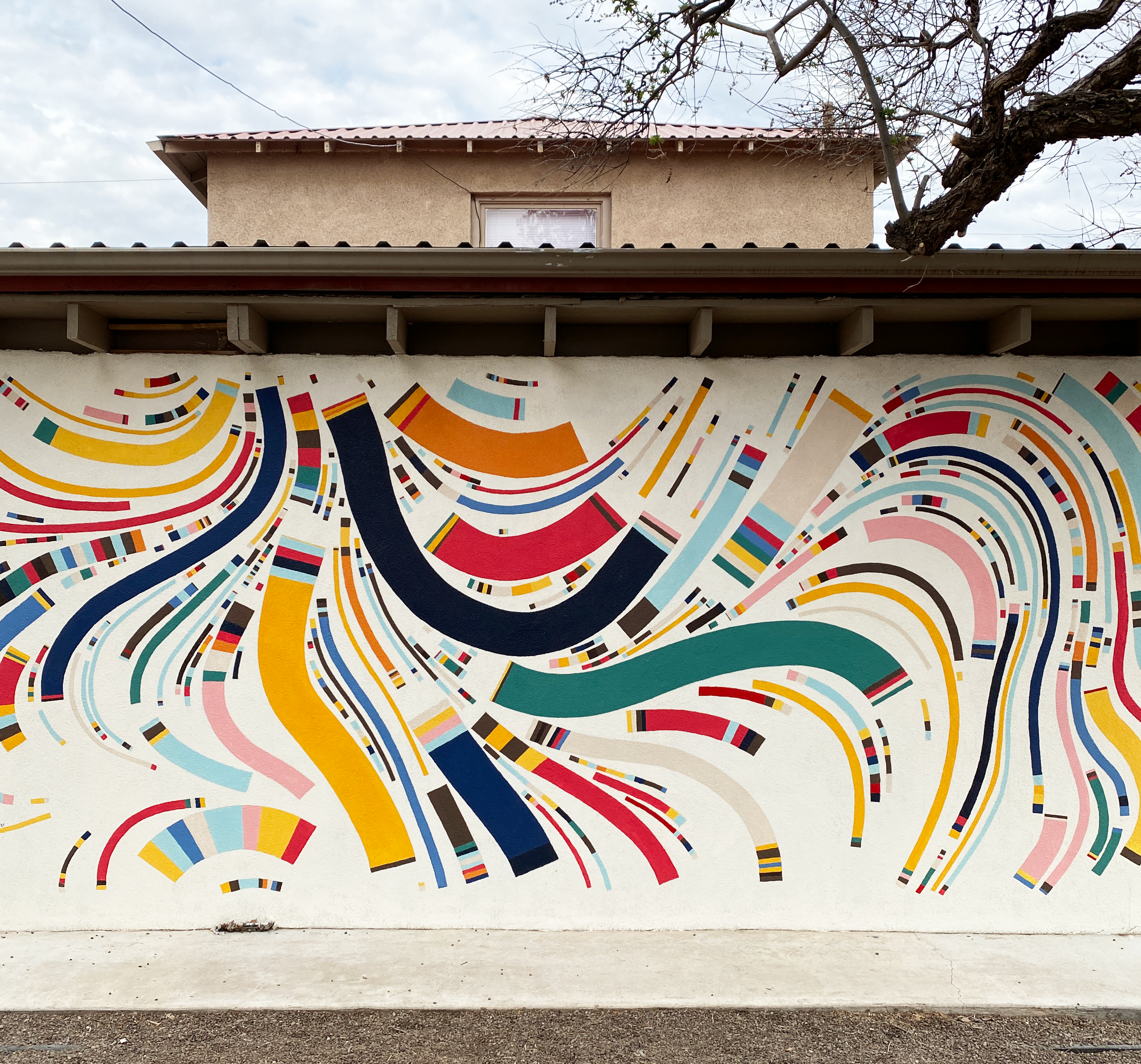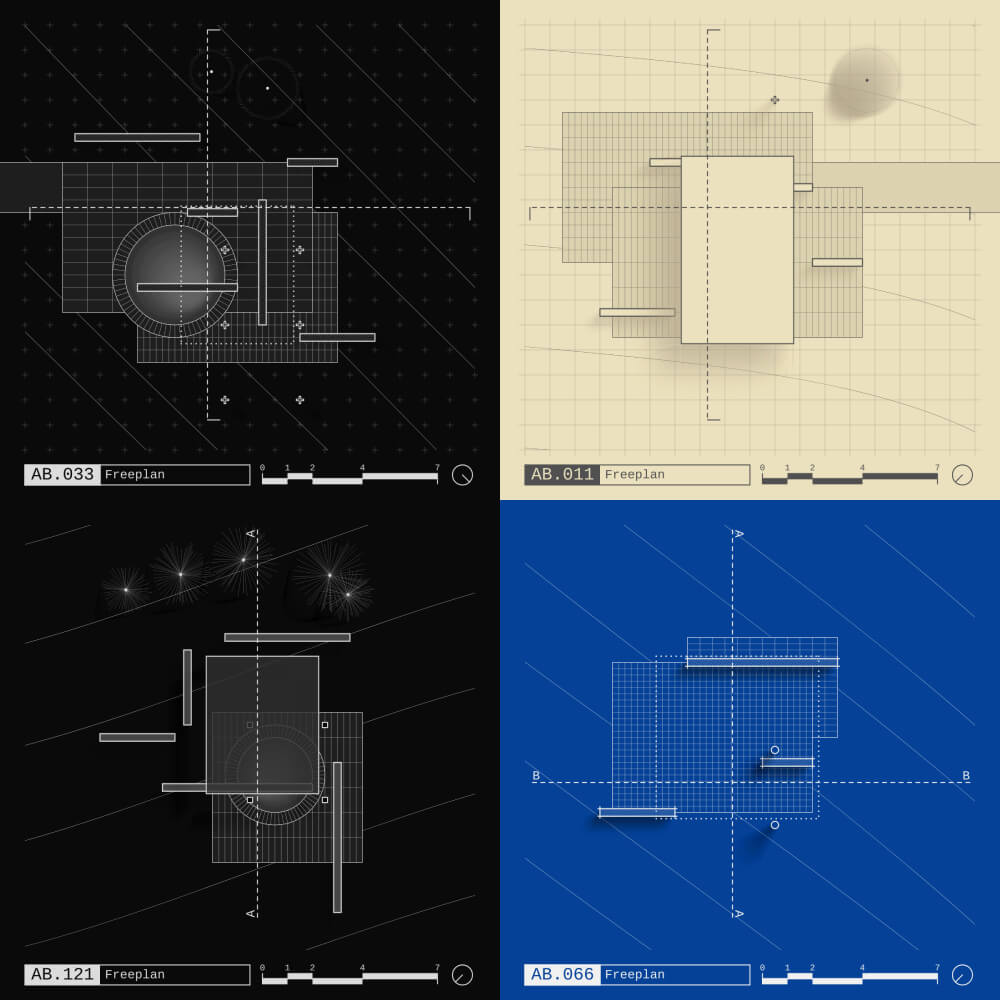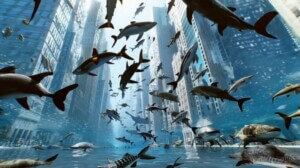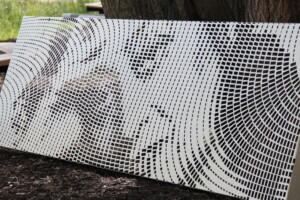On the main east-west drag in Marfa, Texas, the Art Blocks house/gallery sits between an upscale prix fixe restaurant and a church. With four bedrooms, three baths, a large yard, and a freestanding garage, it’s a fairly large house for the town. It would be a rather inconspicuous one were it not for the large mural painted on the north wall of the garage, composed of bright colors and wavy abstract figures floating against a whitewashed wall. Although hand-painted by the artist Tyler Hobbs, the mural is part of a series of abstract computer-generated artworks called Fidenza, a set of 999 unique two-dimensional graphic compositions stored as JavaScript code and rendered using a web browser. The name might sound familiar to those who have been following the nonfungible token (NFT) art craze this past year.

Hobbs’s Fidenza series has made headlines for blowing up the digital art market and earning over $177 million in secondary sales to date. The current lowest price for one edition of Hobbs’s Fidenza is 66 Ethereum, or roughly $183,000, putting the work’s value on a par with high-priced artists like Jean-Michel Basquiat and David Hockney.
Why is there a physical Fidenza mural on a garage wall in Marfa? Because Art Blocks facilitated Hobbs’s generative project. Art Blocks is both a broker and a curator for code-based NFT artworks as well as a platform for facilitating specifically “on-chain” generative art projects. This means not just that these digital works are associated with blockchain transactions as a receipt of ownership, but that they use the blockchain transaction as a “seed” to generate an entirely unique composition. In the case of Hobbs’s Fidenza, each purchase transaction (referred to as “minting”) generates a new composition whose features such as color palette, shape direction, and density are all controlled by an algorithm that filters parts of the transaction ID (the token) and uses it to change the parameters of the final output. Like a Kinder Egg surprise, buyers do not know what their Fidenza will look like until the transaction has gone through.
Part of this will not sound new to any architect or designer who has used parametric tools or programmed algorithms. Code-based design methods have been around since at least the 1960s and have experienced waves of popularity. In the late 1970s and early ’80s, computer-generated art began to legitimize itself as a discipline, leading to publications such as Computer Graphics and Art magazine (1976–78) and Herbert Franke’s Computer Graphics, Computer Art (1971). The aesthetics begotten by these experiments were geometric and entropic, as artists leveraged computation’s ability to produce controlled yet unexpected effects. In this search for new visual forms and illusions, the computer became the artist’s creative collaborator.
In the 1990s, Net Art (the movement that celebrated early internet aesthetics) somewhat overshadowed generative art, but it would undergo a resurgence in the post-2000 creative coding boom associated with DIY programming tools such as Processing and openFrameworks. These open-source initiatives introduced a new generation to visual mathematics and the legacy of generative art, resulting in a group of artists focused on producing not just algorithmically driven artworks but also freely available tools and knowledge. Some architects embraced this new knowledge and collaborated with generative artists to explore the architectonics of computational methods, many of which were cataloged in the seminal 2010 book Form+Code in Design, Art, and Architecture, written by Casey Reas and Chandler McWilliams and published by Princeton Architectural Press.
Today’s digital design methods are directly inherited from this lineage. Grasshopper and other parametric design tools packaged popular techniques into their interfaces and produced workflows for generating architectural elements from triangulation, geometry packing, and recursive algorithms. Eventually, what characterized the parametric turn of the early 2010s became a default formal language associated with specific visions of what a computationally designed futuristic architecture should look like.
What I find particularly exciting about the recent generative art movement is the vast variety of effects being produced. In contrast to the earlier wave of generative design in architecture that was characterized by an overuse of Voronoi algorithms and smooth parametrized surfaces, the visual landscape being crafted today is much more diverse and entropic. Meaning: There is no singular style associated with contemporary generative design. And that’s a good thing.
Computational design does not require a specific visual language or style. Take, for example, a recent Art Blocks project titled Free Plan by the Turkish architect known as XNMTRC, a series of Miesian pavilion plans that explore its eponymous architectural concept. XNMTRC’s project is an “on-chain” algorithm that generates unique plans according to modernist principles, resulting in compositions reminiscent of Mies van der Rohe’s Barcelona Pavilion and Farnsworth House. While outsiders to the discipline may regard the generated outputs as striking geometric compositions, architects arrive with disciplinary interpretations. In other words, Free Plan is a computational project that extends far beyond computational interpretation. From an academic perspective, Free Plan contributes to a larger dialogue that entwines both architectural and computational history and theory (think Mies meets Vera Molnár). From a techno-economic perspective, it fits provocatively into debates around labor and automation in architectural design.

Free Plan also illustrates how drawings and images can hold speculative value in the tradition of “paper architecture,” resurrecting a prior art market interest in architectural drawings. Similar to OMA selling Madelon Vriesendorp paintings for extra income in the 1970s, some architects may now be able to market their media to a wider audience. The current price, for example, of one iteration of Free Plan on the secondary market is 0.2 Ethereum or ~$500. The advent of NFT technology has allowed artists whose medium is primarily digital to sell and distribute their work just like physical media artists. This, in turn, has catalyzed a renewed interest in generative art as a commodity evidenced by the emergence of Art Blocks and other blockchain-based generative art platforms. This year’s Venice Art Biennale even established a Decentral Art Pavilion, which hosted works from several prominent generative artists.
While volatile market speculation around art has always existed, and architects have at times benefited from an art market that values architectural media, it is possible that what the current generative art and broader digital art movement offers us is new perspectives on algorithmic collaboration. These do not have to be solely technical; they could be conceptual, theoretical, economic, or cultural. I personally have had a few fascinating debates online with artists surrounding retrograde aesthetics in emerging artworks. In these conversations we discussed why, for instance, some generative projects use nostalgic effects such as artificial grain in code-based images or why some artists insist on reproducing hand-drawn effects. As somewhat of an outsider to the world of generative art history, I have learned from both curators and artists, and this, in turn, has affected how I approach generative design.
It is easy to get seduced by the striking and imaginative imagery coming out of NFT generative art platforms. But it is important to understand that these artists have been working through this medium long before it was trendy—and long before it was financially viable. Generative art is an autonomous discipline with its own history and cultural values. At times those values align with those of architects, and fruitful collaborations can emerge. Architects could also learn something about generosity from the current wave of generative art. The generosity of coders, programmers, artists, and technologists who make their knowledge freely available is abundant in these growing communities. It has led to record donations to the Processing Foundation, which supports coding camps for students, fellowships for artists and researchers, and, of course, development of the Processing tools. Programming has become much more accessible thanks to this generosity, whereas architecture remains a highly exclusive and often inaccessible body of knowledge. Perhaps the takeaway here is neither purely visual nor formal nor technical: These developments offer lessons in sharing expertise as well as opening previously exclusive knowledge to wider audiences.
Galo Canizares is a designer, writer, and educator currently researching the socio-technical networks of relations between design’s softwarization and the architectural imagination. He is the author of Digital Fabrications: Designer Stories for a Software-Based Planet, a collection of essays on software and design.











